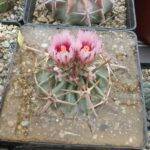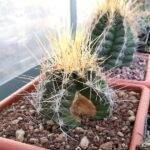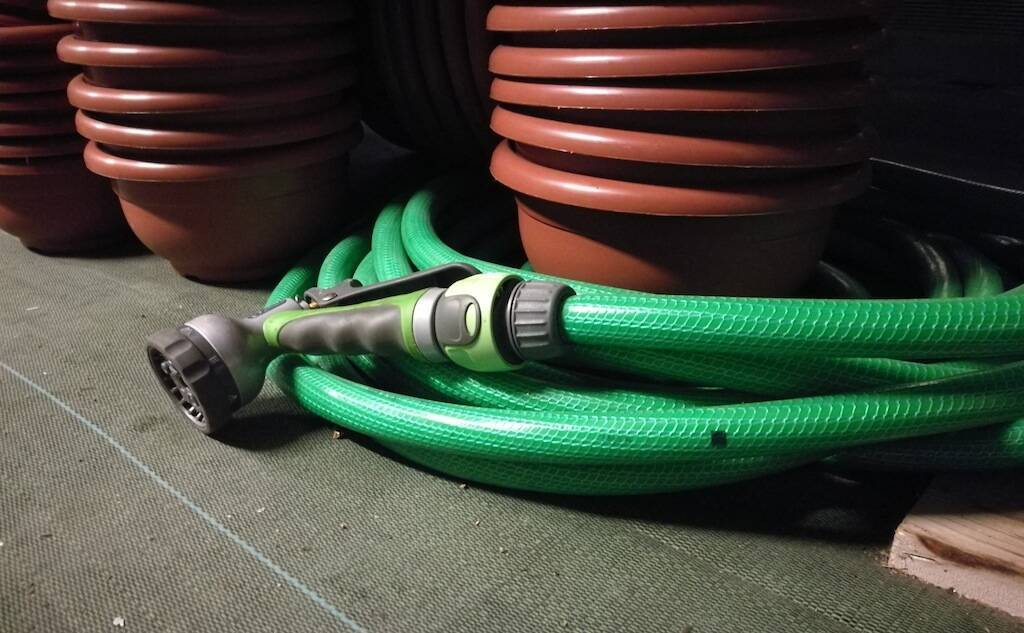Watering is still one of the most debated themes among those who approach the cultivation of cacti and succulents in general. How much water do cacti want? When should succulent plants be watered? How often should succulents be watered? These above are just some of the most frequent questions – and I fly over, for obvious reasons, on another question that I have often heard asked: But should cacti be watered…?
Like any living thing, succulent plants need water. How, how much and when water depends on many factors, such as the time of the year, the place where you live (North or South Italy, for example?), temperatures, environmental humidity, the substrates you use, the size of the pots, and more… Before going into the details of watering, let us sure to definitively put aside false convictions legacy of who knows what experiences at the edge of the absurd. For example, let’s get the fact that cacti and succulent plants have to be watered with droppers or watered once in a blue moon.
General introduction

In nature, in the sub-desertic areas where these plants live, it often rains torrentially and for whole days. Or it rains every afternoon with the clouds discharge impressive quantities of water if compared to those we are used to seeing in Europe. For one thing, in many areas of Mexico (Baja California, for example, as I was able to experience during one of my trips), between September and October is time for extreme rains often accompanied by cyclones and hurricanes. From June to September, always in many sub-Saharan areas of Mexico, there are intense showers with daily frequency, especially in the afternoon. Moreover, in nature, the differences between night and day temperatures can be such as to produce abundant dew in the early morning hours: also this is water that many cacti can absorb to quench their thirst (not unlike the fog that surrounds, in Chile, the Copiapoa).
So it makes no sense to say tout court that cacti should be scarcely wet and at long intervals. In vegetative season, between the end of March and September/October, cacti drink well. Some species of genera like Sclerocactus, Pediocactus, Escobaria, Opuntia, also drink in winter. Other succulent plants – Africans, for example – can have inverted the cycle of the seasons, since while we are in summer at their latitudes in winter, therefore should be wet during our winter months and left dry in our summer months.
This is to say that, in addition to the factors of cultivation, we must first consider the basic conditions that plants have in their habitat. That said, some limits should be set. Just for a convention or because the times are mainly dictated by the temperatures, we can therefore say that basically the Cactaceae and the succulents of the Northern hemisphere must be watered in the period between the end of March and the beginning of October (better still, at least in Northern Italy, stop in mid-September to give time to the plants to prepare for winter).
What kind of water to use

If the question were: What is the best water for cacti? the answer would be clear: the rainy one. For those who cultivate in greenhouses and have the opportunity to collect rain in large tanks the problem would not even arise. Rainwater is definitely the best: it has an acidic pH and does not contain limestone or chemicals such as chlorine, to name one. In general, for plants, so not only succulents, it is the ideal solution (as well as the most natural, in all senses). It is not only its intrinsic characteristics that make rainwater the best: it is also the type of watering determined by rain that contributes to the final result. Exposed to rain, the plants receive water in variable but constant quantity, drop by drop for a time that can go from a few minutes (in the case of summer showers) to a few hours. Not only that: the water is enriched with oxygen and also this has a beneficial effect on the plants. To focuses it is enough to keep two identical plants and leave one to the rain, keeping the other to shelter and wetting it with tap-water. After a few weeks, the differences between the two plants will be evident: the one quenched by the rain will be more luxuriant, cleaner, more vital. More healthy, in short.
For those who have a greenhouse but can not collect rainwater, because it needs a peculiar system, or for those who grow on balconies or terraces, the alternative to rain is water for domestic use. In the countryside, as in my case, there is well water, generally quite calcareous and therefore, in the long run, less good for plants. One solution, in these cases, is to fill cans or barrels with well or tank water and let it decant for at least 24 hours, adding citric acid or specific products (available on the market) capable of acidifying it and bringing its pH between 6 and 6,5. Then, leaving the water decant for a day, the chlorine can evaporate almost completely, as well as any impurities or heavy elements can settle on the bottom of the container.
Generally, for my plants in the greenhouse, I do this: the day before watering, I prepare the water to use, leaving it in two tanks of 80 litres. Therefore, since in the countryside the water is ordinarily calcareous, I add the right amount of acidifier to sweeten it. After 24 hours, I water the plants using a pump connected to the pipe that draws water from the vessels.
I keep outdoor a very lot of plants (from three-year-old cacti obtained by seedling to adult Cactaceae, but also Agave and Aloe) from the end of March to the end of October. Needless to say, these get all the water the sky sends down. If, as happened during the last summers, it does not rain for weeks, I use the well water left to decant. On more than one occasion, however, the outdoor plants have been raining for several days. None plants died because, thank the air and the wind, the soil dries very quickly.
How to water

I water from above, wetting the plants and the soil. Since I use meagre or peat-free substrates, in many cases mainly mineral, I bathe abundantly and in more coats, until I submerge the smaller plants creating a layer of water on the surface. Not only that: usually I do at least two or three coats with the reed of water on each pallet until I see the water dripping abundantly from the drain holes of the vessels. With the soil I use, within a day (if the temperature is hot) the surface of each pot will be dry; in four or five days all the soil will be dry to the depth (also because succulents, in the vegetative season, drink quickly and with greed).
If clay field soil is used in the substrates, the watering must be abundant. It is necessary to revise several times on the plant because the clay, when dry, tends to be waterproof. It is crucial to insist, in short, that water can penetrate deep and well wet the bread of the earth. It is not by chance that this is how it happens in nature, with the rain insistently falling for hours until it penetrates the surface of the fields. In the past, at the first watering after the dry winter, I used to see that some plants did not swell, despite watering that I thought abundant. They were mostly plants in clay and inerts. After having realized that the clay was too dry and compact, I started to wet more frequently, but above all insisting more on each plant, I submerged the plants with water. Result? After a couple of days, they had fully recovered and had regained volume: the water had managed to penetrate in deep, and the Cactaceae had finally drunk enough.
Beware of other false myths, such as that about the delicate Ariocarpus, that people say it is almost resistant to water. Nothing is more wrong: in the vegetative season the Ariocarpus drink a lot, and it is only this mistaken belief that has led to thinking that these plants never grow. With abundant watering, the Ariocarpus speed up the growth (even if being Cactaceae, they are relatively slow in the development).
When to wet and how often
The answers to questions like when to wet and how often to water could be endless. As stated above, we must consider first the plants and their origin (for example, an Echinopsis and a Lithops have very different needs), then the factors of cultivation, starting from the area where we grow. About this topic, some conventions can be assumed. For most of the Cactaceae and of the non-caudiciform succulents (for instance, the Crassulas), the watering period matches the vegetative season. In North Italy, this is from the end of March to the end of September; in South Italy even October and part of November. I start watering at the end of March, if the days are hot enough, otherwise I wait for the beginning of April. I stop the watering in mid-September, even if it is still hot, to allow the plants to begin to lose fluids and to prepare for the winter.

Between the end of March and mid-September, I water with varying frequencies, approximately every 15 days, intensifying if necessary in the warmer months, when I can bathe every 8-10 days. Very important, after the dry winter, during which the plants tend to deflate (in some cases also remarkably) is to start gradually watering again. The first two or three waterings must be light, not as abundant as in June or July. In fact, the plants must start to drink little at a time because if they find water immediately available in large quantity they absorb it quickly with the risk of swelling so fast to break. It happened to me a few times. I had a Frailea, a Thelocactus and some Ferocactus that after the first two waterings have swollen immediately, with the result that the stem has split. The plants are not dead but taking a risk because the internal tissue if exposed, can be easily attacked by bacteria that then go to trigger rottenness (not to mention the aesthetic damage of a plant with a literally pierced coast).
As for the frequency of wetting, the old rule can be useful: in doubt, water only if the soil is well dry. We see it from the superficial layer: if pressing with the finger, we feel humid, better to wait. This is a basic rule based on common sense – it is difficult for a cactus to die of thirst, but it is easier that it can rot for an excess of water, especially if in very organic soil. Then the experience will tell us when to give water to our plants. To me, for example, it is enough to touch the stem or weigh the pot to understand if the plant is thirsty and if the soil is still wet or not.
I reserve special treatment for my Cactaceae seedlings of at least one year and for the few succulent plants that I have (Crassula, Echeveria etc.): for these, the frequency of watering is greater than the Cactaceae in general. Leaf plants obviously tend to disperse water more than cacti, while the seedlings have the desire to grow and to support them are wetted more frequently than adult plants.
In August, usually, I suspend watering for cacti (not for seedlings and not for succulents in general). The Cactaceae, in the hotter months, tend to go in estivation, that is slow the growth and in some cases block it to restart as soon as the temperatures return to tolerable levels (in August in my open greenhouse the temperature can exceed 40 degrees). For the plants I keep outside in the vegetative season, as I wrote above, I leave it to nature. They can take water for days and days or stay whole weeks in the dry. If the drought extends, I provide with extra watering.
Regarding the times in which it is better to wet the plants, it is better to do it early in the morning, before the sun begins to raise the temperatures, or in the late afternoon. Even better in the evening, so the plants will have all the night – basically with lower temperatures than the day – for absorbing the water before it can evaporate on the surface of the pot.
It is essential do not water immediately after a repotting: the roots may have been damaged during the operation; it is good to wait at least ten days before wetting the soil, to allow the rooting apparatus to heal its wounds and avoid the risk of rot that wet soil could trigger.
Nebulization

Some recommend spraying the succulents often. I do not find it useful. I did it for years, at first, then I saw that the plants had no benefit at all. Even to nebulize them abundantly, in a few minutes they completely dry and I do not see the point in wasting time to wet the cactus and succulent stem. The only useful nebulizing, in my opinion, is that with water added with fungicides or acaricides. Over the years, since I have strengthened the plants with the cultivation regime and the soil I use, I have reduced these treatments a lot. Usually, I give the copper once in spring and once in autumn, before dry, and an acaricide a few times during the growing season.
Fertilization (or “manuring”)
I discuss fertilization (also written “fertilisation”) in a specific post, at this specific link. Here it is enough to recall that cacti and succulents must be fertilized with specific products with low nitrogen content and not generic, for example for ornamental plants or for the vegetable garden. The fertilizers for succulents are based on nitrogen (N), phosphorus (P), potassium (K), to which various micro-nutrients are added. For succulents, in general, it is good that the ratio between the three main elements, N-P-K, is in the order of 5-15-30 (another basic formulation used is 1 of nitrogen, 2 of phosphorus and 4 of potassium). Fertilizers, in good substance, little nitrogenous and with high percentages of phosphorus and potassium.
Watering and repotting
Caution: freshly repotted succulents should never be watered. It is good to wait at least ten days from repotting before wetting the soil. The repotted plants may be nebulized so that the topsoil can get settled the surface, especially in the cases of habitat reconstruction, but for wetting the earth in-depth is better not to hurry.
SUBSCRIBE TO THE SITE – If you liked this article, subscribe to the site to have access to all the contents for one year or three months depending on the formula you choose. Here you will find terms and conditions.
SUBSCRIBE TO THE NEWSLETTER – If you want to receive the free newsletter every time new content is published (even if you have not subscribed to the site), fill in the fields at this link!
My video
Related articles
When and how fertilize cacti to have aboundant blooms
Substrates: which is the best soil for cacti and succulent plants?
Diseases and pests of cacti and succulents: how to recognize them
How to make cacti and succulents bloom: what you need to know
© The texts, videos, photos and graphic elaborations of the site “Il fiore tra le spine” are original material and are covered by copyright. It’s forbidden to reproduce them in any way.



